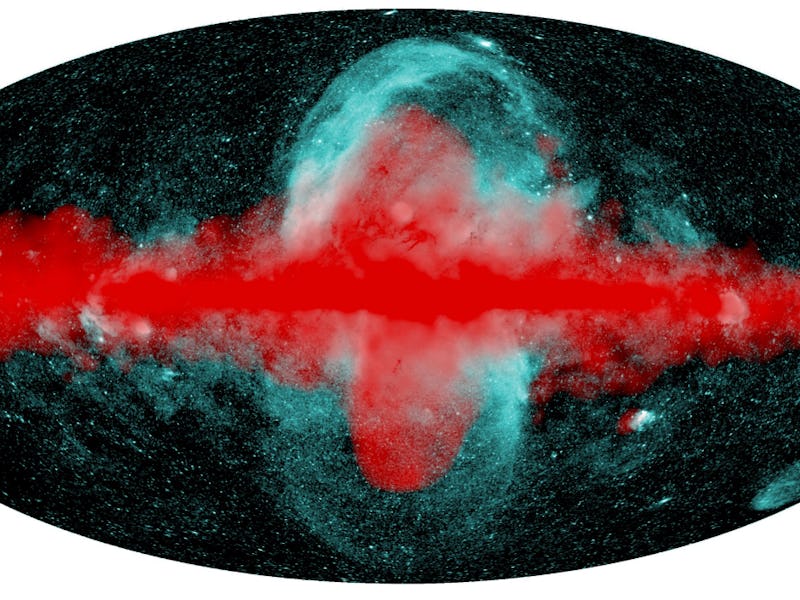Astronomers are stumped by giant bubbles at the center of the Milky Way
But they're not sure how they formed.

The center of the Milky Way is a busy place. The galaxy's core is bustling with a supermassive black hole, the birth of thousands of stars, and their explosive deaths.
And now, a team of astronomers has discovered giant bubbles made up of hot gas that occupy the center of the galaxy, and they're not quite sure how they got there.
Their findings are detailed in a study published on Wednesday in the journal Nature.
The discovery was made using the eRosita all-sky survey, an X-ray telescope built by the Max Planck Institute for Extraterrestrial Physics in Germany. The telescope conducted its first full sweep of the cosmos back in June, doubling the number of known X-ray sources in the universe discovered over 60 years of X-ray astronomy.
The result was a complete map of X-ray emissions across the galaxy.
Map of the Milky Way.
Peter Predehl, a senior scientist at the Max Planck Institute for Extraterrestrial Physics, and lead author behind the new study, recalls seeing the total sky image for the first time and noticing the bubble structure at the center of the Milky Way.
"The discovery was made by chance," Predehl tells Inverse. "We saw these bubbles which sweep out from the central region of the galaxy in both directions, and are more pronounced on the south side."
The bubbles are made up of hot gas which reaches millions of degrees in temperature, and their structure extends 14 kiloparsecs, a measurement equivalent to 3,260 light years, above and below the galactic center.
The discovery resembles another one made in 2010 of the Fermi bubbles at the center of the Milky Way, extending above and below the plane of the galaxy for over 25,000 light-years. However, the researchers are not quite sure whether these two massive structures are connected.
Although the researchers behind the discovery are still not sure how these bubbles formed, they have a few ideas already.
The first hypothesis is that the bubbles were a result of an extremely energetic event that took place in the center of the Milky Way triggered by the galaxy's black hole. Like most galaxies, the Milky Way has a supermassive black hole at its center known as Sagittarius A*, which has a mass of about 4 million times that of the Sun.
The event may have then caused this outpour of hot gas that formed the bubble structure.
This image shows the large-scale bubbles in the center of the Milky Way.
Another alternative is that the bubbles are a continuous effect of star forming regions in the center of the Milky Way, as well as the death of those stars.
"The central part of the galaxy is a very dense region; a lot of star forming is going on there," Predehl says. "Having stars born, and then dying stars with explosions of supernova, that cycle is much shorter in the center of the Milky Way."
The amount of energy generated by the hot gas corresponds to tens or hundreds of thousands of supernovae explosions. As a star nears the end of its life, it runs out of fuel and eventually collapses under the weight of its own gravity, resulting in a massive explosion known as a supernova.
Although that sounds like a large number of supernovae, Predehl explains that it would take the hot gas around 20 million years to cool down and form this structure.
"A hundred thousand supernovae explosions over 20 million years," he adds "That means you would have one every thousand years, which is not much."
The researchers behind the discovery are planning to make follow-up observations of certain regions of the bubbles in order to better understand how they formed, and get a better sense of what goes on in this active central area of our galactic neighborhood.
Abstract: The halo of the Milky Way provides a laboratory to study the properties of the shocked hot gas that is predicted by models of galaxy formation. There is observational evidence of energy injection into the halo from past activity in the nucleus of the Milky Way1–4 ; however, the origin of this energy (star formation or supermassive-black-hole activity) is uncertain, and the causal connection between nuclear structures and large-scale features has not been established unequivocally. Here we report soft-X-ray-emitting bubbles that extend approximately 14 kiloparsecs above and below the Galactic centre and include a structure in the southern sky analogous to the North Polar Spur. The sharp boundaries of these bubbles trace collisionless and non-radiative shocks, and corroborate the idea that the bubbles are not a remnant of a local supernova5 but part of a vast Galaxy-scale structure closely related to features seen in γ-rays6 . Large energy injections from the Galactic centre7 are the most likely cause of both the γ-ray and X-ray bubbles. The latter have an estimated energy of around 1056 erg, which is sufficient to perturb the structure, energy content and chemical enrichment of the circumgalactic medium of the Milky Way.